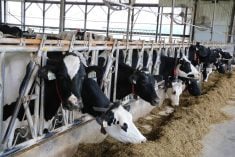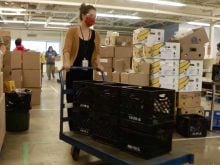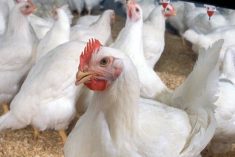While the ag sector is welcoming the latest program announcement under the Sustainable Canadian Agricultural Partnership (S-CAP), farm groups say there’s not a lot of time to get the paperwork in.
“I think there are benefits for farmers across the board and I do give credit to [Manitoba Agriculture] minister Johnson and the department for rolling this out, but the window for application is pretty narrow,” said Cam Dahl, Manitoba Pork general manager. “Applications need to be in by July 11 for this program; it would have been good to see a little longer of an application window.”
Read Also

Local farm businesses, groups look forward to Manitoba Ag Days 2026
Most of agriculture is seemingly at Manitoba Ag Days each January: Manitoba agribusinesses and farm groups look forward to connecting with farmers at the 2026 show.
Why it matters: Funding is available to producers for various building and equipment upgrades.
According to a joint release between the federal and provincial governments in mid-June, the funding is meant to support Manitoba producers and processors in the areas of environmental sustainability, food safety and traceability. It’s the latest in a series of funding announcements rolled out since S-CAP came into effect earlier this year.
The announcement covered two programs: the Sustainable Agri-Processing Program (SAP) and the Food Safety and Traceability Program.
Funding under SAP is available in four areas: building envelope, lighting and ventilation upgrades; input use efficiency; water use efficiency and waste use efficiency.
The first stream aims to help applicants assess and upgrade agri-food and agri-product facilities and equipment to save energy and greenhouse gas. Funding is available for up to 50 per cent of the project cost, up to a maximum of $25,000 per project. Projects will have a maximum of 12 months to be completed.
Dahl says that, for his members, this is the area they should be focused on.
“Specifically for hog producers, I think the biggest benefit is going to come around things like improvements to the ventilation systems. I think that’s going to be the biggest potential uptake,” he said. “That will help with energy use and also help with things like biosecurity by preventing things like PED [porcine epidemic diarrhea] spread as well as other diseases.
“It’s a good initiative, and one which I do applaud.”
The input-use efficiency stream aims to reduce agri-food and agri-product wastage during harvest and the storage of crops and ingredients. It also targets waste during processing. Those tapping into the stream can get funding towards assets and systems purchases that will mitigate that waste. Funding is available for up to 50 per cent of the project cost, up to a maximum of $50,000 per project. Projects falling under this stream will have two years to be completed.
This is the stream that grain farmers might find most useful. For instance, it includes eligible expenses like on-farm metering systems for harvesting equipment to maximize crop yields during harvest, and humidity monitoring and control equipment to reduce the volume and value of wasted ingredients in storage.
While producers are technically eligible, the other two streams under SAP are more geared towards processors.
The water-use efficiency stream targets the amount of water used by agri-processors in production and sanitation, the treatment of wastewater or the recovery of nutrients from wastewater. Funding is available for up to 50 per cent of the project cost, up to a maximum of $250,000 per project.
The waste-use efficiency stream covers projects reducing or diverting agri-processing waste, byproducts or co-products. Funding is available for up to 50 per cent of the project cost, up to a maximum of $250,000 per project.
The Food Safety and Traceability Program will fund the adoption or improvement of food safety and traceability practices in the agri-food and agri-product sectors, according to government. The program will provide up to 60 per cent of eligible expenses, up to a maximum of $30,000, for food safety initiatives, and up to half of eligible expenses, up to a maximum of $30,000, for traceability initiatives.
Eligible applicants include agri-food processors, agri-product processors, licensed commercial kitchens, food warehouse distributors and Indigenous communities, groups and governments.
Food sector reaction
Food & Beverage Manitoba executive director Michael Mikulak said he welcomed the initiatives.
“I think these grant programs are phenomenal. The industry needs them, especially right now, as we’re going into this focus on sustainability,” he said.
Mikulak’s organization represents many of the province’s agri-food processing companies.
But while Mikulak endorses the spirit of these initiatives, he said they can be difficult to access for small and medium-sized processors.
“Timelines can be tight, and the amount of knowledge and skills needed to do the actual grant application can be very limiting,” he said. “It tends to favour much larger players.”
Mikulak doesn’t fault the funding programs, but he says there is a lack of infrastructure to help those smaller companies benefit from them. However, Mikulak is working towards the establishment of an incubation centre aimed at providing food processing services to these smaller companies (see page 3). That incubation centre could access the funding such as this and pass on the benefits to their clients, he said.
“The incubation centre that we’re proposing is targeted at the smaller players precisely for this reason, because you need to be able to find those kinds of ways to create a kind of collaborative infrastructure so that they can actually access some of these programs,” he said.
Keystone Agricultural Producers president Jill Verwey said she was happy that the latest rollout included funding aimed at producers, but she also raised concerns about the quickly approaching deadline.
“KAP can help assist producers to find out what programs are applicable and to point them in the right direction and to the right people to talk to,” she said.
















